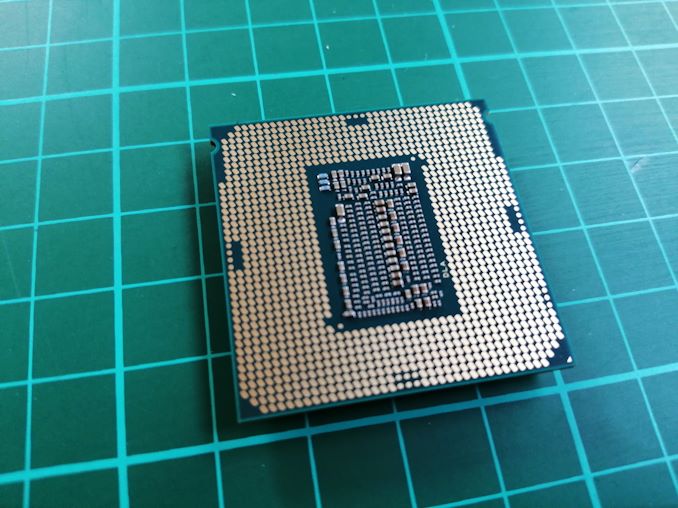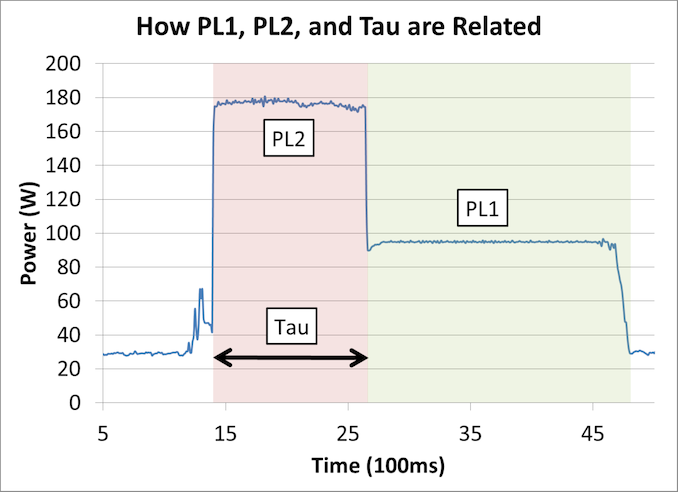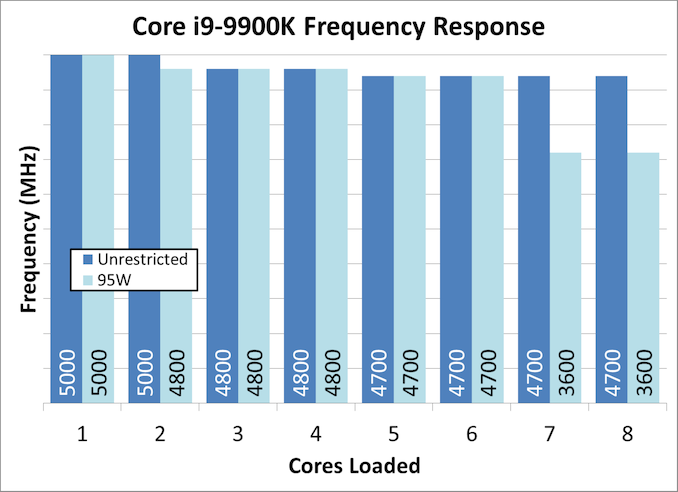The Intel Core i9-9900K at 95W: Fixing The Power for SFF
by Ian Cutress on November 29, 2018 8:00 AM EST
There is a lot of discussion about processor power recently. A lot of the issues stem around what exactly that TDP rating means on the box, and if it relates to anything in the real world. A summary of Intel’s official declaration boils down to TDP as the sustained processor power at long periods, however almost zero motherboards follow that guideline. As a result users will usually see much higher sustained power, although with much higher performance. Some small form factor systems rely on setting these limits, so we tested a Core i9-9900K with a 95W limit to see what would happen.
Intel and TDP
We recently published a sizeable analysis on what Intel officially means by TDP, and the associated values of PL1, PL2, and Tau. You can read it all here, although what it boils down to is this diagram:
When a processor is initially loaded, it should enter a state where PL2 describes the maximum power for a time of Tau seconds. When in this PL2 state, the CPU follows Intel’s per-core Turbo table rules, which reduces the frequency based on the number of cores loaded.
After Tau seconds, the CPU should drop down to a PL1 maximum sustained power value, which is usually identical to TDP. Depending on the CPU, this may reduce the frequency to the base frequency, or well below the all-core turbo frequency.
Technically PL2 is obtained over a moving average window, Tau, such that any low power moments on the processor will 'give budget back' to the turbo mode, however the graph above is the easiest way to see the high turbo mode on a fully loaded processor.
So while Intel defines a value for PL1, PL2, and Tau, almost zero consumer motherboard manufacturers actually follow it. There are many reasons why, mostly relating to overengineering the motherboards and wanting users to have the best performance at all times. The only times where these values follow any form of Intel guidance is in small form factor PCs.
For example, I tested an MSI Vortex G3 small form factor desktop at an event last year. It was using a processor normally rated for 65W TDP, and in a normal desktop that processor would push over 100W because the motherboard manufacturer in that system did not put any limits on the power, allowing the power to fall within Intel’s per-core turbo values. However, in this Vortex system, because of the limited thermal capabilities, the BIOS was set to run at 65W the whole time. This made sense for this form factor, but it meant that anyone looking for benchmarks of the processor would be misled – the power profile set in the BIOS was in no-way related to how that CPU would run in a standard desktop.
A Core i9-9900K with a 95W Limit
To put this into perspective, for this review we are using a Core i9-9900K which has a sustained TDP rating of 95W. When we compare the per-core frequencies of a 95W limited scenario and a normal ‘unrestricted scenario’, we get the following:
When a single core is loaded, the CPU is in 5.0 GHz mode as we are well under the power limit. There’s a slight decrease of 200 MHz in the 95W at two cores, but this disappears when 3-6 cores are loaded, with both setups being equal. The major difference happens however when we are at 7-8 cores loaded: because of the power consumption, the Core i9-9900K in 95W mode drops down to 3.6 GHz, which happens to be its base frequency.
This arguably means that we should see a correlation in most benchmarks between the two parts, but not if maximum load is ever required.
This Review
For this review, we’re putting the Core i9-9900K at a 95W power limit (as measured by the internal registers of the system) and running through our CPU test suite to see if how large the performance deficit is between the Core i9-9900K in a thermally unlimited scenario compared to a small form factor system deployment.
Pages In This Review
- Analysis and Competition
- Test Bed and Setup
- 2018 and 2019 Benchmark Suite: Spectre and Meltdown Hardened
- CPU Performance: System Tests
- CPU Performance: Rendering Tests
- CPU Performance: Office Tests
- CPU Performance: Encoding Tests
- CPU Performance: Legacy Tests
- Conclusions and Final Words












101 Comments
View All Comments
Rukur - Monday, December 3, 2018 - link
9900K comes out of the box with 5Ghz so its going to win on games. The prize it a game stopper but.woggs - Thursday, November 29, 2018 - link
"This rises to 44.2 if the processor is fixed to 95W" but there is no data point on the plot at that spot. A mouse-over labeling of that plot would be very-helpful.romrunning - Thursday, November 29, 2018 - link
I don't understand - the article title says "Fixing the Power for SFF", and yet no motherboards with the form factor typically used in SFF systems were actually tested. The motherboards listed were all ATX; no mini-ITX or even micro-STX boards were used.Why not? Wouldn't this have provided valuable insight for those looking to purchase a SFF system, custom or DIY, to see which mfgs cap the TDP usage or let it go full range?
The author said he tested a MSI Vortex G3 small form factor desktop last year. Well, why not get some comments from ASRock, Gigabyte, ASUS, and MSI as to whether it's standard practice for them to limit CPUs to a specific power limit in their BIOS for those SFF boards.
Fro example, I'd love to know if that sweet-looking ASRock DeskMini GTX Z390 that was recently reviewed can take the i9-9900k rated at 95W to the full "unlimited" power settings. I can put 450-600W SFX/SFX-L PSUs into a SFF system, so I'd like to know if I can get the full performance out of the CPU or if the mfg locks the power draw in the BIOS.
SaturnusDK - Thursday, November 29, 2018 - link
Why is this article, and Anandtech in general, using 1000 unit OEM prices for Intel products which are typically 15-20% less than the lowest retail price you can find. But use the highest you can find retail prices for AMD products? It seems like Anandtech is deliberate trying to make people think Intel products have any value when the reality is that they don't.Rezurecta - Thursday, November 29, 2018 - link
Good re-review. Although, Ian doesn't seem to want to call Intel out. This is OBVIOUSLY something initiated by Intel. If the 9900k were to run in spec it would be slower than the 2700x in a LOT of benchmarks. Intel couldn't have that for such a massive hot monolithic die. That's why all the shady sponsored benchmarks and having the processor way out of spec.It's obvious Intel is hurting. Let's hope this brings about a competitive landscape again.
kernel-panic - Thursday, November 29, 2018 - link
it would be nice if somewhere you let readers know what TDP, PL1 and PL2 mean. I enjoy this kind of articles but I'm not related with the terminology.Icehawk - Thursday, November 29, 2018 - link
It's in the (by now) linked article at the very beginningMr Perfect - Thursday, November 29, 2018 - link
How do motherboards treat the non-k versions of these CPUs? When I built my mITX machine, I bought the non-K processor since there wouldn't be any overclocking going on. Just how locked is a locked CPU? Technically, this could be considered turboing ratehr then overclocking and could be applied to the non-Ks.Targon - Sunday, December 2, 2018 - link
It is possible that Intel won't release a non-k version of these chips, just because there won't be a significant enough performance benefit vs. the AMD 2700X if the chips were not being pushed to their absolute limit.stux - Thursday, November 29, 2018 - link
An interesting point that you make is that a 9900K constrained to 95W performs like an unconstrained 9900K for single threaded loads and an unconstrained 9700K for multithreaded loads.The 9700K has half the threads, so that is an interesting claim, and I think the key is how does the 9700K perform when constrained to 95W.
Hyperthreading is supposed to be a big win to perf/W, thus I’d expect 9900K at 95W to be more efficient than the 9700K for the same perf, which is a definitive win too.
How does the 9700K at 95W perform in the multi threaded benchmarks?